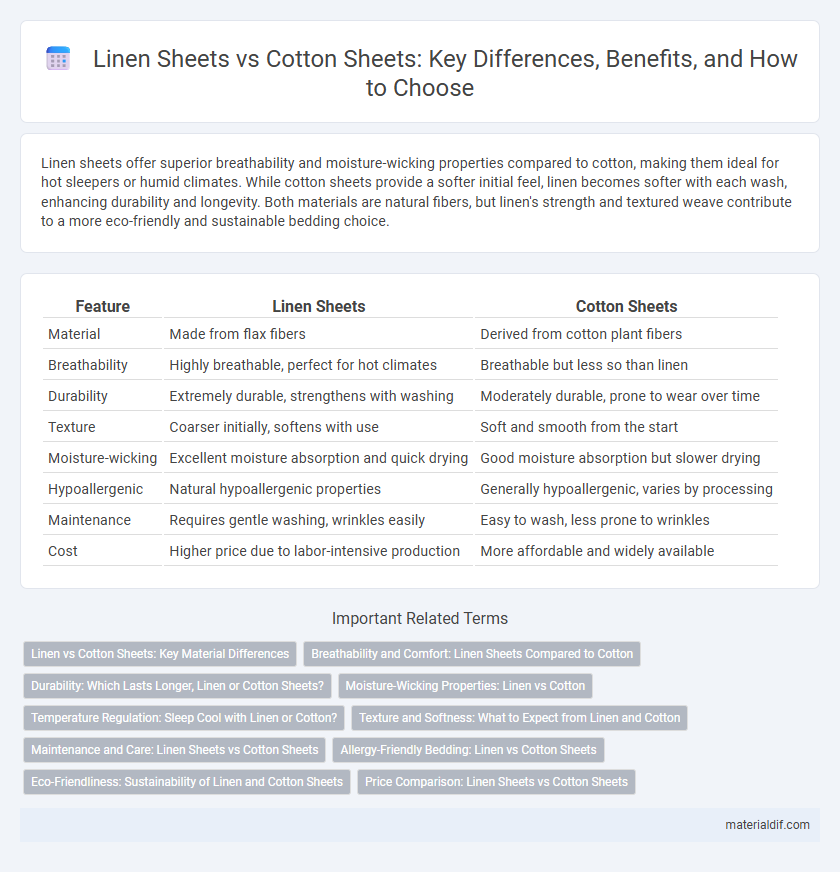Linen sheets offer superior breathability and moisture-wicking properties compared to cotton, making them ideal for hot sleepers or humid climates. While cotton sheets provide a softer initial feel, linen becomes softer with each wash, enhancing durability and longevity. Both materials are natural fibers, but linen's strength and textured weave contribute to a more eco-friendly and sustainable bedding choice.
Table of Comparison
| Feature | Linen Sheets | Cotton Sheets |
|---|---|---|
| Material | Made from flax fibers | Derived from cotton plant fibers |
| Breathability | Highly breathable, perfect for hot climates | Breathable but less so than linen |
| Durability | Extremely durable, strengthens with washing | Moderately durable, prone to wear over time |
| Texture | Coarser initially, softens with use | Soft and smooth from the start |
| Moisture-wicking | Excellent moisture absorption and quick drying | Good moisture absorption but slower drying |
| Hypoallergenic | Natural hypoallergenic properties | Generally hypoallergenic, varies by processing |
| Maintenance | Requires gentle washing, wrinkles easily | Easy to wash, less prone to wrinkles |
| Cost | Higher price due to labor-intensive production | More affordable and widely available |
Linen vs Cotton Sheets: Key Material Differences
Linen sheets, made from flax fibers, offer superior breathability and moisture-wicking properties compared to cotton sheets, making them ideal for hot climates and sensitive skin. Cotton sheets, derived from cotton plant fibers, are softer and more elastic but tend to retain heat and moisture more than linen. The durability of linen sheets surpasses cotton, with linen fibers becoming softer and stronger after multiple washes, whereas cotton may weaken and pill over time.
Breathability and Comfort: Linen Sheets Compared to Cotton
Linen sheets provide superior breathability due to their loosely woven fibers that allow better air circulation and moisture-wicking, making them ideal for hot sleepers. Cotton sheets, especially those made from Egyptian or Pima cotton, offer a softer feel but can trap heat more easily compared to linen. The natural texture of linen enhances comfort by regulating temperature and reducing night sweating, which many users find more refreshing than the smoother surface of cotton sheets.
Durability: Which Lasts Longer, Linen or Cotton Sheets?
Linen sheets are renowned for their exceptional durability, often lasting up to 10-15 years with proper care due to the strength of flax fibers, which naturally resist wear and tear better than cotton. Cotton sheets, while softer initially, typically have a shorter lifespan of around 3-5 years because cotton fibers are finer and more prone to breaking down with frequent washing. The durability advantage of linen makes it a smart investment for long-term bedding that retains quality and texture over time.
Moisture-Wicking Properties: Linen vs Cotton
Linen sheets offer superior moisture-wicking properties compared to cotton sheets due to their natural flax fibers, which absorb and release moisture quickly, keeping sleepers dry and comfortable. Cotton sheets tend to retain moisture longer, which can lead to a damp feeling and less breathability. This makes linen an ideal choice for hot sleepers or those in humid climates seeking enhanced moisture management and temperature regulation.
Temperature Regulation: Sleep Cool with Linen or Cotton?
Linen sheets excel in temperature regulation due to their natural breathability and moisture-wicking properties, making them ideal for hot sleepers or warm climates. Cotton sheets, particularly those made from Egyptian or Pima cotton, offer softness and moderate breathability but may retain more heat compared to linen. Choosing linen sheets ensures a cooler, drier sleep environment by promoting airflow and preventing overheating throughout the night.
Texture and Softness: What to Expect from Linen and Cotton
Linen sheets offer a distinctively textured and breathable surface with a natural slub, providing durability and a slightly crisp feel that softens over time with washing. Cotton sheets are known for their smooth, soft texture that feels gentle against the skin and usually offer a plush, cozy experience right from the first use. Expect linen to become softer and more supple with use, while cotton maintains consistent softness and a silky touch.
Maintenance and Care: Linen Sheets vs Cotton Sheets
Linen sheets require gentle washing in cool water and air drying to maintain their natural fibers and prevent shrinkage, while cotton sheets are more durable and tolerate higher temperatures and machine drying without significant damage. Linen's moisture-wicking properties mean less frequent washing is needed compared to cotton, which can retain more sweat and oils, leading to more frequent laundering. Proper maintenance of linen sheets extends their lifespan and enhances softness, whereas cotton sheets offer easier care but may wear out faster with repeated harsh washing.
Allergy-Friendly Bedding: Linen vs Cotton Sheets
Linen sheets, made from flax fibers, are naturally hypoallergenic and resistant to dust mites, making them an excellent choice for allergy-friendly bedding compared to cotton sheets. Their moisture-wicking properties help keep the sleep environment dry, reducing the likelihood of mold and mildew that can trigger allergies. While cotton is breathable, it often requires chemical treatments that may irritate sensitive skin, whereas linen's natural composition supports healthier sleep conditions.
Eco-Friendliness: Sustainability of Linen and Cotton Sheets
Linen sheets are more eco-friendly due to flax plants requiring less water, pesticides, and fertilizers compared to cotton crops, which significantly reduces environmental impact. The biodegradability of linen and its longer lifespan contribute to lower waste production, making it a sustainable bedding choice. Cotton sheets, especially conventional ones, often involve intensive water use and chemical treatments, posing challenges for sustainable production.
Price Comparison: Linen Sheets vs Cotton Sheets
Linen sheets typically cost more than cotton sheets due to the labor-intensive production process and durability of flax fibers. While cotton sheets are generally more affordable and widely available, high-quality cotton varieties like Egyptian or Pima can approach linen sheet prices. Investing in linen sheets offers long-term value because of their enhanced breathability, moisture-wicking ability, and longer lifespan compared to standard cotton sheets.
Linen Sheet vs Cotton Sheet Infographic

 materialdif.com
materialdif.com